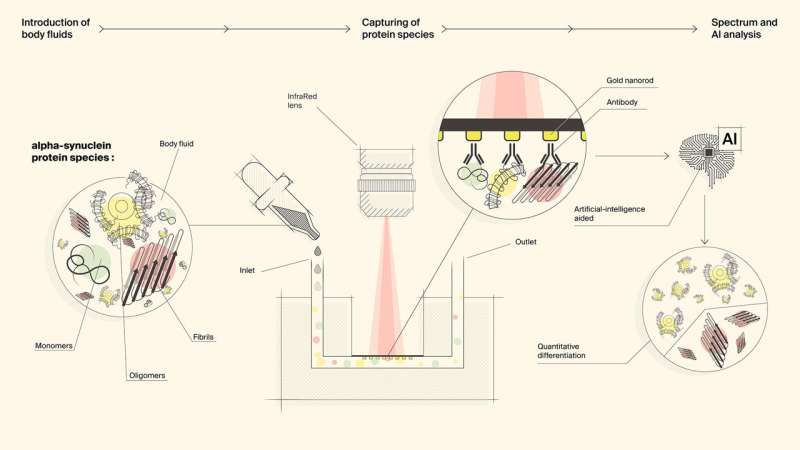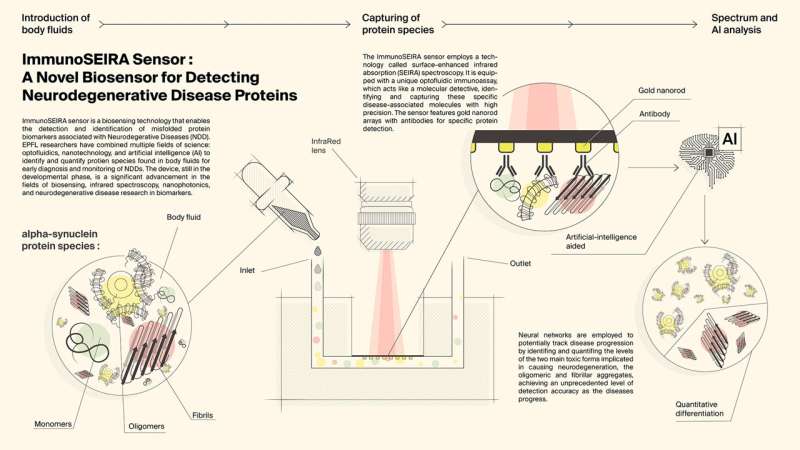
By combining multiple advanced technologies into a single system, EPFL researchers have made a significant step forward in diagnosing neurodegenerative diseases (NDDs) such as Parkinson’s disease (PD) and Alzheimer’s disease (AD).
This novel device is known as the ImmunoSEIRA sensor, a biosensing technology that enables the detection and identification of misfolded protein biomarkers associated with NDDs. The research, published in Science Advances, also harnesses the power of artificial intelligence (AI) by employing neural networks to quantify disease stages and progression.
This significant technological advance holds promise not only for early detection and monitoring of NDDs, but also for assessing treatment options at various stages of the disease’s progression.
Treatment of neurodegenerative diseases faces a significant challenge due to the lack of effective diagnostic methods for early detection and monitoring of disease progression. Protein misfolding, a common mechanism in neurodegeneration, has been identified as a key event in disease progression.
It is hypothesized that healthy proteins misfold first into oligomers in early stages and into fibrils in later stages of the disease. These misfolded protein aggregates circulate in the brain and biofluids and also accumulate as deposits in the brains of deceased NDD sufferers. But the development of tools to detect these tell-tale signs of disease—known as biomarkers—has remained elusive until now. The hurdles to accurate detection are multiple, including limits of current technology to accurately separate and quantify different protein aggregates.
Combing multiple advanced technologies into one sensor
To create this advanced NDD biomarker sensor, researchers at Professor Hatice Altug’s Bionanophotonic Systems Laboratory (BIOS) and Professor Hilal Lashuel’s Laboratory of Molecular Neurobiology and Neuroproteomics (LMNN) have combined multiple fields of science: protein biochemistry, optofluidics, nanotechnology, and artificial intelligence (AI).
“Unlike current biochemical approaches which rely on measuring the levels of these molecules, our approach is focused on detecting their abnormal structures. This technology also allows us to differentiate the levels of the two main abnormal forms implicated in the development and progression of NDDs, oligomers and fibrils,” says Lashuel
The ImmunoSEIRA sensor employs a technology called surface-enhanced infrared absorption (SEIRA) spectroscopy. This method allows scientists to detect and analyze the forms of specific disease-associated molecules, known as biomarkers, associated with neurodegenerative diseases. The sensor is equipped with a unique immunoassay, which acts like a molecular detective, identifying and capturing these biomarkers with high precision.
“In our paper, we present a technological solution that integrates nanoplasmonics, cleanroom nanofabrication, microfluidics, immunoassay, AI, and advanced biochemical methods,” says Ph.D. student and main author of the paper Deepthy Kavungal. “Our ImmunoSEIRA sensor exhibits structural sensitivity and the capability to monitor a panel of complementary biomarkers with high specificity from small sample volumes in complex biomatrices.”

Joining the power of nanotechnology and artificial intelligence
The ImmunoSEIRA sensor features gold nanorod arrays with antibodies for specific protein detection. It enables real-time specific capture and structural analysis of target biomarkers from extremely small samples. Neural networks, a subset of AI algorithms, are then employed to identify the presence of specific misfolded protein forms, the oligomeric and fibrillary aggregates, achieving an unprecedented level of detection accuracy as the diseases progress.
Lashuel believes that this is a significant advance in disease detection, adding that, “since the disease process is tightly associated with changes in protein structure, we believe that structural biomarkers, especially when integrated with other biochemical and neurodegeneration biomarkers, could pave the way for more precise diagnosis and monitoring of disease progression.”
The EPFL research team went a step further to show that the ImmunoSEIRA sensor can be used in real clinical settings, i.e. in biofluids. They were able to accurately identify the specific signature of abnormal fibrils, a key indicator of neurodegenerative diseases, even in complex fluids like human cerebrospinal fluid (CSF).
Professor Altug explains that the next step with this new technology “is to continue to expand its capabilities and evaluate its diagnostic potential in Parkinson’s disease and the growing number of diseases caused by protein misfolding and aggregation.”
The results of this study mark a significant advancement in the fields of biosensing, infrared spectroscopy, nanophotonics, and neurodegenerative disease biomarkers. The deployment of the AI-aided ImmunoSEIRA sensor is a welcomed advance for early NDD detection, disease monitoring, and drug efficacy assessment, addressing the critical need for timely intervention and treatment of neurodegenerative diseases.
More information:
Deepthy Kavungal et al, Artificial intelligence–coupled plasmonic infrared sensor for detection of structural protein biomarkers in neurodegenerative diseases, Science Advances (2023). DOI: 10.1126/sciadv.adg9644
Provided by
Ecole Polytechnique Federale de Lausanne
Citation:
A novel biosensor for detecting neurogenerative disease proteins (2023, July 13)
retrieved 16 July 2023
from https://phys.org/news/2023-07-biosensor-neurogenerative-disease-proteins.html
This document is subject to copyright. Apart from any fair dealing for the purpose of private study or research, no
part may be reproduced without the written permission. The content is provided for information purposes only.










